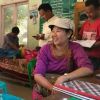
- Place
A Shared Locale
The research area is Taungthaman village tract, Mandalay City where the Yadanabon University is located. There are four villages, namely Taungthaman, Htantaw, Simihtun and Obo in this village tract. Before 2000, the dwellers of these four villages were living off the land through farming, fishing, toddy climbing, weaving etc. In 2000, Yadanabon University was established and a lot of farmland was taken over for the school campus. This was a disruption in the lives of the villagers who were farmers and they had to change their subsistence patterns drastically.
The university that came into being in 2000 is in the heart of this place and from maps in the council office, it is clear that it was a conscious act by the community councils of the four villages there to have the university reside in their midst.
There are three very clear social engagement goals for Mandalay University and its partners:
- Pedagogy of local crafts alternatives to plastic consumption: Simply through observation of Yadanabon University and the surrounding villages, one can see the ubiquity of accumulated trash and garbage in the form of plastic bottles and plastic bags. Tackling this will require the management of already existing plastics and the introduction of local crafts alternatives to plastic packaging.
- Interventions for local snack-food street vending in an organised manner for the students of the university: One of the Apyogaungs (leaders of the adult-girls) expressed the desire for more community-oriented management of local snack-food street venders near the Yadanabon University. Most of the street venders would like to sell their goods within the University Campus but at present they are not allowed to enter.
- Knowledge production of the social (and colonial) history of Amarapura for potential heritage conservation: Within the village tract, lie the Pagoda Kyauktawgyi which is covered with beautiful 19th century murals and the U Bein bridge which was built in 1851 over the Taung thaman lake and is the longest teak wood bridge in the world. As a village head pointed out, the younger generations of the village need to cherish their locality. Currently, they aren’t very interested in their villages and the village head emphasized the weakness of the social connection between the younger generations and the locality. This social tie will be strengthened through aforementioned knowledge production around the potential heritage sites and 19thcentury cultural materials that are present in the community.
Now, more than twenty thousand students are studying in Yadanabon University and despite the disruption in their farming practices, this large student population is the source of many potential jobs for the villagers. This is one obvious that the establishment of the University influenced the development of the local community. But there are other ways the University has influenced the community and vice versa. Thus this invisible co-existence between school and community becomes as critical one in terms of the educational environment.
Apart from the main outcomes of this research, i.e., finding out the ways to solve the socio-cultural problems that local people have expressed and creating pedagogy in terms of learning and doing research at the community level, this project will also aim to provide a model for social engagement of the University in my country.




